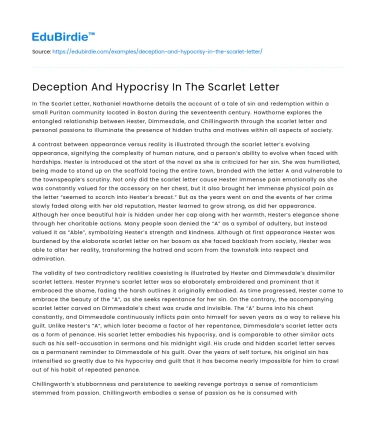In The Scarlet Letter, Nathaniel Hawthorne details the account of a tale of sin and redemption within a small Puritan community located in Boston during the seventeenth century. Hawthorne explores the entangled relationship between Hester, Dimmesdale, and Chillingworth through the scarlet letter and personal passions to illuminate the presence of hidden truths and motives within all aspects of society.
A contrast between appearance versus reality is illustrated through the scarlet letter’s evolving appearance, signifying the complexity of human nature, and a person’s ability to evolve when faced with hardships. Hester is introduced at the start of the novel as she is criticized for her sin. She was humiliated, being made to stand up on the scaffold facing the entire town, branded with the letter A and vulnerable to the townspeople’s scrutiny. Not only did the scarlet letter cause Hester immense pain emotionally as she was constantly valued for the accessory on her chest, but it also brought her immense physical pain as the letter “seemed to scorch into Hester’s breast.” But as the years went on and the events of her crime slowly faded along with her old reputation, Hester learned to grow strong, as did her appearance. Although her once beautiful hair is hidden under her cap along with her warmth, Hester’s elegance shone through her charitable actions. Many people soon denied the “A” as a symbol of adultery, but instead valued it as “Able”, symbolizing Hester’s strength and kindness. Although at first appearance Hester was burdened by the elaborate scarlet letter on her bosom as she faced backlash from society, Hester was able to alter her reality, transforming the hatred and scorn from the townsfolk into respect and admiration.
Save your time!
We can take care of your essay
- Proper editing and formatting
- Free revision, title page, and bibliography
- Flexible prices and money-back guarantee
The validity of two contradictory realities coexisting is illustrated by Hester and Dimmesdale’s dissimilar scarlet letters. Hester Prynne’s scarlet letter was so elaborately embroidered and prominent that it embraced the shame, fading the harsh outlines it originally embodied. As time progressed, Hester came to embrace the beauty of the “A”, as she seeks repentance for her sin. On the contrary, the accompanying scarlet letter carved on Dimmesdale’s chest was crude and invisible. The “A” burns into his chest constantly, and Dimmesdale continuously inflicts pain onto himself for seven years as a way to relieve his guilt. Unlike Hester’s “A”, which later became a factor of her repentance, Dimmesdale’s scarlet letter acts as a form of penance. His scarlet letter embodies his hypocrisy, and is comparable to other similar acts such as his self-accusation in sermons and his midnight vigil. His crude and hidden scarlet letter serves as a permanent reminder to Dimmesdale of his guilt. Over the years of self torture, his original sin has intensified so greatly due to his hypocrisy and guilt that it has become nearly impossible for him to crawl out of his habit of repeated penance.
Chillingworth’s stubbornness and persistence to seeking revenge portrays a sense of romanticism stemmed from passion. Chillingworth embodies a sense of passion as he is consumed with taking revenge on Dimmesdale, which results in the corruption of not only his appearance, but also his soul. When Roger Chillingworth is first introduced to the reader, he is portrayed as somewhat a kind old man, who has just planted the seeds for revenge, but realizes that he is a factor for the sin that Hester and Dimmesdale have committed. To the townspeople, at first glance, Chillingworth seems to be an angel coming to save Dimmesdale as he first moves in to help cure Dimmesdale’s illness. The townspeople are grateful, but his malice becomes increasingly prominent as he latches onto Dimmesdale like a leech, slowly draining the life out of Dimmesdale. As Chillingworth becomes increasing cosummed in his plot of revenge, his appearance reflects his desires, and he increasingly transforms to the point of devilish, as his “visage was getting sooty with the smoke” from Hell’s “infernal fuel.” The unadulterated nature around him “leaves a barren and blasted spot”, and “a circle of ominous shadow moves along with his deformity, whichever way he turned himself.” Chillingworth is so invested into revenge that it becomes impossible for him to be saved, as he drips of sin and poison.
Hidden motives and truth are always present within society as long as people feel passion towards one another. It is how individuals react to surface level appearances of their experiences that defines their reality.






 Stuck on your essay?
Stuck on your essay?

